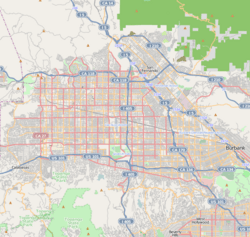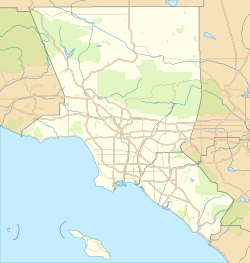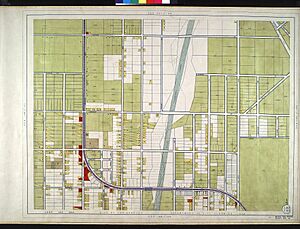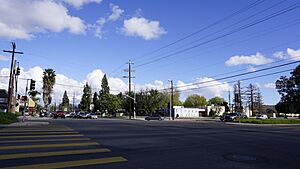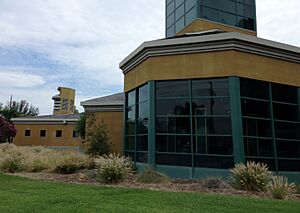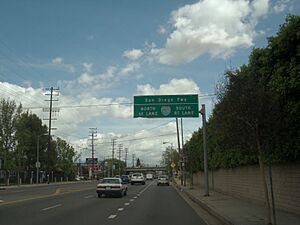North Hills, Los Angeles facts for kids
Quick facts for kids
North Hills
Sepulveda
|
|
|---|---|
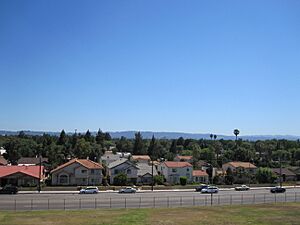
North Hills and the valley from the VA Hospital.
|
|
| Country | |
| State | |
| County | Los Angeles |
| City | Los Angeles |
| City Council Districts | • District 6 • District 7 • District 12 |
| Neighborhood Councils | • North Hills East • North Hills West |
| Named for | Location in the north of Los Angeles |
| Elevation | 256 m (841 ft) |
| Population
(2000)
|
|
| • Total | 56,946 |
| Time zone | UTC-8 (PST) |
| • Summer (DST) | UTC-7 (PDT) |
| ZIP code |
91343
|
| Area code(s) | 818 and 747 |
North Hills, once called Sepulveda, is a neighborhood in the San Fernando Valley area of Los Angeles, California.
It started as a farming community known as Mission Acres. After World War II, it became a new suburban area and was renamed Sepulveda. This name honored the important Sepúlveda family of California. In 1991, the community was renamed North Hills.
Geography
Where is North Hills located?
North Hills is in the middle of the San Fernando Valley, which is part of Los Angeles. The 405 Freeway cuts through it. It is about 21 miles (34 km) northwest of downtown Los Angeles.
North Hills is surrounded by other neighborhoods:
- To the west: Northridge
- To the east: Panorama City
- To the south: Van Nuys
- To the north: Granada Hills and Mission Hills
The area uses Area codes 747 and 818. The main ZIP code for North Hills is 91343.
What are the neighborhood boundaries?
The official boundaries for North Hills are used by its two neighborhood councils: North Hills East and North Hills West. The neighborhood covers about 4.31 square miles (11.16 km²).
- The western border is Bull Creek.
- The eastern border is the Pacoima Wash.
- The southern border is Roscoe Boulevard.
- The northern border is Lassen Street.
The 405 Freeway divides North Hills into two parts: North Hills East and North Hills West. North Hills West is about 2.38 square miles (6.16 km²), and North Hills East is about 1.93 square miles (5.00 km²).
History
Early Valley Life
The San Fernando Valley was first home to native people like the Tongva, Tataviam, and Chumash. They lived in villages, mostly in the southern part of the valley where water was easier to find. The North Hills area was a flat plain that could flood in winter.
Spanish and Mexican Times
Europeans first arrived in the valley in 1769 with the Spanish Portolá expedition. They named it Valle de Santa Catalina. Later, the Mission San Fernando Rey de España was founded in 1797. This mission took control of most of the valley's land, including the area of North Hills, and its native people.
After Mexico became independent from Spain, the missions were closed down in 1833. The land of the San Fernando Mission became a large ranch called Rancho Ex-Mission San Fernando. In 1846, this ranch was sold to Eulogio de Celis.
American Control and Land Sales
After the Mexican-American War, California became part of the United States in 1848. The U.S. government agreed to honor the old Mexican land grants.
In 1875, the northern part of the rancho, which includes North Hills today, was sold to Charles Maclay and George K. Porter. They wanted to develop the land for farming. George K. Porter later owned most of the land that is now North Hills.
In 1887, George K. Porter divided his land into smaller lots for sale. He also set up an irrigation system to bring water for farming. However, a real estate boom ended, and droughts caused problems for farmers. In 1903, Porter sold his land to the San Fernando Mission Land Company.
How North Hills Grew
The early 1900s brought big changes to the San Fernando Valley. In 1905, Los Angeles planned to bring water from the Owens Valley using the Los Angeles Aqueduct. This project, finished in 1913, helped the valley grow quickly. New towns like Van Nuys were planned. The Pacific Electric Railway also expanded, connecting the valley to Los Angeles.
Mission Acres was an early farming community in the North Hills area. It had one-acre plots for farming, with water from the aqueduct. The Pacific Electric railway also had a stop there.
In 1927, the residents of Mission Acres renamed their community Sepulveda. This name came from the important Sepulveda family. Sepulveda Boulevard is still a main street in North Hills today. The area grew a lot between the 1930s and 1950s.
In 1937, efforts were made to protect Sepulveda from floods. The Our Lady of Peace Catholic Church was built in 1937, and its parish was started in 1944.
After World War II
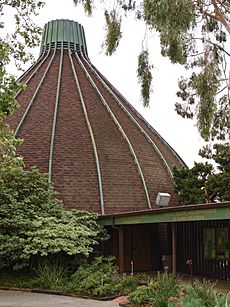
North Hills was mostly rural until the 1950s. Then, it started to change into a suburban area with many homes. More apartment buildings were built in the 1960s.
Before the 405 Freeway was built, Sepulveda Boulevard was a main road. Many motels were built along it for travelers. The Good Knight Inn, built in 1945, still looks like a castle today.
- Our Lady of Peace Catholic school was completed in 1954.
- Plummer Elementary School was finished in 1952.
- The Sepulveda Veterans Administration Hospital opened in 1955.
- Francisco Sepulveda Junior High School was completed in 1960.
In 1991, people living in the western part of Sepulveda voted to create a new community called North Hills. Soon after, the entire area of Sepulveda was renamed North Hills by the City of Los Angeles. The city then created two sub-neighborhoods: North Hills West and North Hills East.
In 1999, a damaged airplane landed safely on Hayvenhurst Avenue. By 2000, North Hills had a population of 52,333 people. The number of Latino American and Asian/Pacific Islander residents increased a lot.
In 2012, a small community called Woodley Hill, located in the northwest part of North Hills, decided to become part of Northridge. Residents felt they had more in common with Northridge.
In 2014, the Nanak Sadan Sikh Temple and Community Center opened on Nordhoff Street.
In 2016, a local man was convicted of murder. Community groups organized a rally to promote family acceptance and end discrimination.
By 2020, many homes in North Hills were built between 1940 and 1979.
Demographics
Who lives in North Hills?
In 2020, North Hills had a population of 53,764 people within its Neighborhood Council boundaries. The larger area covered by the 91343 ZCTA had 62,595 people. The average number of people per square mile was about 10,591.
- About 23.5% of the people were under 18 years old.
- The median age was 35.8 years.
Homes in North Hills
There were 18,545 housing units in North Hills. About half of the homes were owned by residents, and the other half were rented. Most households had 3 to 6 people living in them. About 78% of the homes were family households.
Different Backgrounds
In 2020, the people in North Hills came from many different backgrounds:
- 26.5% identified as White.
- 4.3% as Black or African-American.
- 1.7% as Native American.
- 15.3% as Asian.
- 37.9% as other races.
- 14.2% as two or more races.
A large part of the population, 58.6%, identified as Hispanic or Latino of any race. Most Latinos identified as "some other race."
Other Facts
In 2009, the "Mapping L.A." project found that the average household income in North Hills was $52,456. The population was 60,254 in 2010.
The most common family backgrounds were Mexican (38.4%) and German (2.8%). Many people born outside the U.S. came from Mexico (47.3%) and El Salvador (12.2%).
In 2022, the employment rate was 60.9%, and the average household income was estimated at $77,790.
Education
Public Schools
North Hills is served by schools in the Los Angeles Unified School District (LAUSD).
- Elementary Schools: Gledhill Street Elementary, Langdon Avenue Elementary, Mayall Street School, Parthenia Street School, Vintage Math/Science/Technology Magnet, Lassen Elementary, Valley Region Elementary No. 12, Plummer Elementary, Valley Charter Elementary, Our Community Charter, Rosa Parks Learning Center, Noble Avenue Elementary.
- Middle Schools: Most students attend Sepulveda Middle School. Some students west of Woodley Avenue attend Holmes Middle School. Vista Middle also serves the area.
- High Schools: North Hills high school students attend James Monroe High School. Albert Einstein Continuation High School also serves the area.
Some schools have special programs called magnet programs, like the Gifted / High Ability Magnet at Sepulveda Middle School. School buses are available for students who live far from school.
| Name | Grades |
|---|---|
| Mayall Street Elementary | K-5 |
| Vintage Math/Science/Technology Magnet | K-5 |
| Lassen Elementary | K-5 |
| Francisco Sepulveda Middle | 6-8 |
| Gledhill Street Elementary | K-5 |
| Albert Einstein Continuation | 9-12 |
| Valley Region Elementary No. 12 | K-5 |
| Plummer Elementary | K-5 |
| James Monroe High | 9-12 |
| Valley Charter Elementary | K-5 |
| Our Community Charter | K-8 |
| Rosa Parks Learning Center | K-5 |
| Langdon Avenue Elementary | K-5 |
| Noble Avenue Elementary | K-5 |
| Vista Middle | 6-8 |
Private Schools
North Hills also has several private and religious schools:
- Los Angeles Baptist Middle School/High School
- North Hills Prep
- Valley Presbyterian Elementary
- Our Lady of Peace Elementary
- Centers of Learning
- New Generation
- Holy Martyrs Armenian Elementary
- Valley High School/Site 1
- Valley High School/Site 2
Many North Hills families host international students who come to study in the U.S. This allows them to share their culture and learn about other countries.
| Name | Grades |
|---|---|
| Los Angeles Baptist Middle School/High School | 6-12 |
| North Hills Prep | 7-12 |
| Valley Presbyterian Elementary | K-6 |
| Our Lady of Peace Elementary | K-8 |
| Centers of Learning | K-12 |
| New Generation | K-6 |
| Holy Martyrs Armenian Elementary | K-5 |
| Valley High School/Site 1 | 6-12 |
| Valley High School/Site 2 | 6-12 |
Public Library
The Los Angeles Public Library Mid-Valley Regional Branch is in North Hills. It is one of the largest libraries in the San Fernando Valley. You can find it on Nordhoff Street at Woodley Avenue.
Infrastructure
Getting Around North Hills
The California Interstate 405 freeway has two exits that lead directly into North Hills: exit 68 on Roscoe Boulevard and exit 69 on Nordhoff Street.
Main roads in North Hills include:
- Sepulveda Boulevard
- Roscoe Boulevard
- Hayvenhurst Avenue
- Woodley Avenue
- Haskell Avenue
- Lassen Street
- Plummer Street
- Nordhoff Street
These roads are set up in a grid pattern, like a checkerboard. Roads going north-south are called avenues, and roads going east-west are called streets.
For bikes, there are special bike lanes on Devonshire Street, Nordhoff Street, Parthenia Street, and Woodley Avenue. Plummer Street is also a bike route where cyclists share the road with cars.
The Los Angeles County Metropolitan Transportation Authority (Metro Bus) and the Los Angeles Department of Transportation (DASH) operate bus lines through the neighborhood.
Parks and Fun Places
North Hills has a few places for outdoor fun:
- North Hills Community Park is a 3.895-acre (1.576 ha) park in North Hills East. It has play areas for kids and sports fields. It was created in 2001.
- The Mid-Valley Library also has a grassy area with paths and benches.
More parks are located just outside North Hills:
- The large Sepulveda Recreation Center is in Panorama City, right next to North Hills.
- Other nearby parks include Albert Piantanida Intergenerational Center and Marson Street Pocket Park in Panorama City, and Devonwood Park in Mission Hills.
- To the west, Dearborn Park in Northridge offers more green space.
In 2022, some people wanted to turn a historic house on Plummer Street into a park instead of a new school. They wanted more green space in the neighborhood. The house will be saved, but the Valor Academy Elementary School will still be built.
Healthcare
North Hills is home to the large Veterans Administration Sepulveda Ambulatory Care Center. This center provides medical care for veterans in the San Fernando Valley.
Landmarks
The Poodle Sculpture
A 12-foot (3.7 m) ivy poodle living sculpture sits on a utility pole at Plummer Street and Hayvenhurst Avenue. Brian Welch, a North Hills resident, created it in the 1980s. It quickly became famous in the area. Every December, the Welches turn the poodle into a reindeer!
Filming Locations
Many movies have been filmed in North Hills:
- Terminator 2: Judgment Day
- Halloween
- Halloween II
- American Beauty
- Step Brothers
The Sepulveda VA Clinic was used in Step Brothers. A famous scene from Terminator 2: Judgment Day, where a truck crashes into a river channel, was filmed at Bull Creek's Plummer Street/Hayvenhurst Avenue overpass.
Notable people
- Bart Andrus, professional football coach
- Felix Barajas, soccer player
- Kerry Rossall, stuntman and actor
- Sharon Shapiro, gymnast
See also
 In Spanish: North Hills (Los Ángeles) para niños
In Spanish: North Hills (Los Ángeles) para niños


